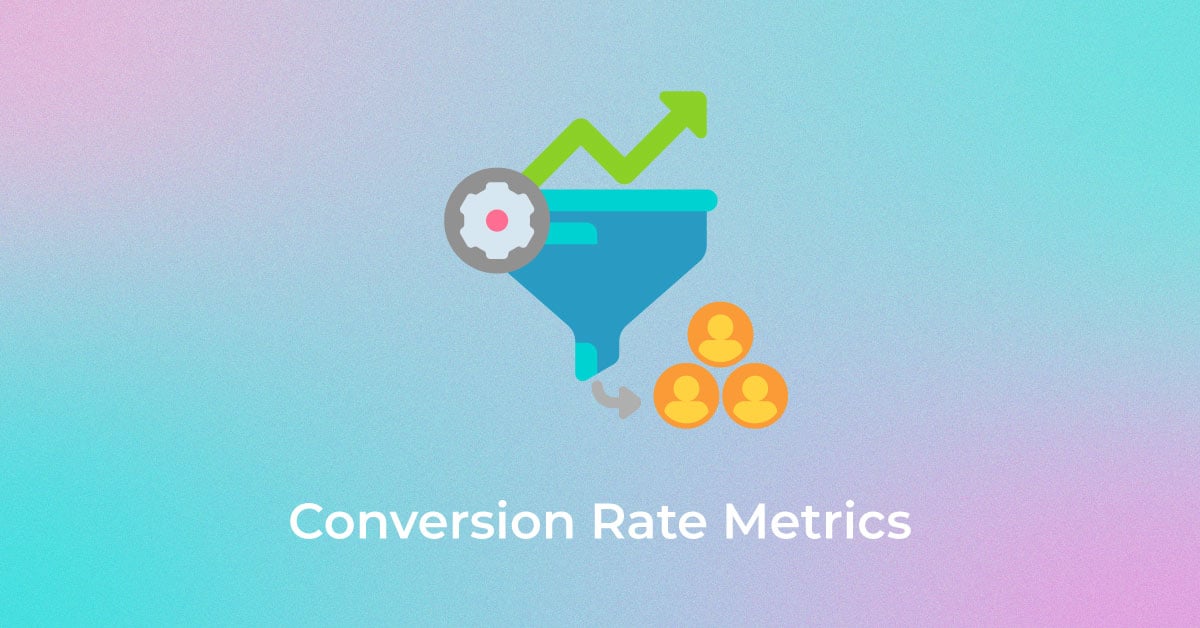Introduction to Conversion Metrics
Defining Conversion Rate in Business Terms
In the dominion of digital marketing and online business, a conversion rate embodies the percentage of visitors who fulfill a predetermined goal, propelling your enterprise toward its overarching objectives. It’s a figure that crystallizes the success of your website or campaign’s ability to persuade visitors to take action—be that purchasing a product, registering for a newsletter, or any other key performance indicator vital to the growth and profitability of your business.
Conversion Rate = (Total Conversions / Total Visitors) × 100
By calculating this metric, you gain clarity on how effectively your strategies are driving results and where optimization is needed. Partnering with CRO services can help identify specific areas for improvement, ensuring your website is optimized for maximum conversions and user engagement.
The Essentiality of Conversion Metrics for Growth
Conversion metrics serve as a linchpin for business growth, enabling a deep dive into how effectively your digital presence translates into tangible results. They not only illuminate strengths and weaknesses in your CRO strategies but also empower data-driven enhancements to drive your organization upward. By measuring conversions, you tailor more resonant messages, optimize user experiences, and hence, catalyze a vital expansion of your customer base and revenues. In essence, these metrics are the compass that guides your business on a trajectory from mere visibility to veritable profitability.
Core Conversion Rate Metrics to Monitor
Sales Conversion Rate vs. Website Conversion Rate
The sales conversion rate zeroes in on the proportion of leads who complete a purchase, while the website conversion rate encompasses a broader scope, tracking all conversions on a site against total visitors. It’s paramount to discern the two; the former targets revenue-driving actions, and the latter, the effectiveness of all desired user responses. While both contribute to a comprehensive understanding of performance, they serve different purposes in pinpointing areas ripe for optimization The sales rate directs focus to the purchasing funnel, and the website rate provides a holistic view of user engagement.
Cost Per Acquisition (CPA) and Return on Investment (ROI)
Cost Per Acquisition (CPA) is the average cost you expend to gain a new customer. It’s essential when assessing the financial impact of your marketing campaigns. A lower CPA implies a more cost-effective strategy in customer acquisition. Conversely, Return on Investment (ROI) measures the profitability of those efforts, indicating the returns garnered from each dollar spent. CPA and ROI are instrumental in steering budget allocations, revealing which campaigns yield the best fiscal outcomes, and informing decisions between pursuing top-line growth or improving bottom-line efficiencies.
Advanced Conversion Metrics for Deeper Insights
Macro vs. Micro Conversions
Macro conversions signify the completion of a main goal—like a substantial purchase or scheduled consultation—that directly impacts your revenue. Micro conversions, on the other hand, are small-scale engagements, such as newsletter signups or account creations, serving as stepping stones toward the end goal. While macro conversions present the primary success metric, micro conversions offer invaluable insights into the customer’s journey. Tracking both types allows you to fine-tune the path to purchase and identify opportunities to nurture potential customers towards those critical macro outcomes, ultimately boosting the overall conversion ecosystem.
Customer Lifetime Value (CLV) and Net Promoter Score (NPS)
Customer Lifetime Value (CLV) quantifies the total revenue a business can expect from a single customer account throughout the business relationship. CLV is profound for segregating high-value customers and tailoring retention strategies to enhance profitability over time. Meanwhile, Net Promoter Score (NPS) gauges customer satisfaction and loyalty by asking how likely they are to recommend your brand. A higher NPS signals that customers are not only content but also enthused to act as brand advocates. Balancing both CLV and NPS provides a dual framework: sustaining profitable relationships while simultaneously promoting organic growth through word-of-mouth referrals.
Conversion Tracking Tools and Techniques
Utilizing Analytics Platforms such as Google Analytics and Hotjar
To unlock a trove of conversion data, integrating tools like Google Analytics and Hotjar into your website is critical. Google Analytics offers a comprehensive suite of tracking features that let you monitor user behaviors, traffic patterns, and conversion ratios. Hotjar complements by providing heatmaps, session recordings, and feedback polls, offering a lens into how users interact with your site beyond mere numbers. These insights can guide you in optimizing for a better user experience and increased conversions. The key to harnessing these conversion rate optimization tools effectively is to implement them strategically, ensuring they’re configured to capture the data that aligns with your specific conversion goals.
The Role of A/B Testing in Conversion Optimization
A/B testing serves as a pivotal instrument in conversion optimization, allowing you to wield empirical evidence to guide website enhancements. By presenting two variants of a web element to a comparable audience, you can rigorously measure which version secures a greater conversion rate, thus eschewing guesswork and hypotheticals. Consistent A/B testing paves the way for incremental improvements and better user engagement. It’s a focused approach to refine everything from call-to-action efficacy to landing page layouts, ensuring each tweak is poised to bolster your conversion goals.
Linking Conversion Rates to Overall Business Strategy
How Tracking Conversions Informs Strategic Decision-Making
Regularly tracking conversion metrics equips you with a robust data set that informs strategic decisions. You glean actionable insights into user behavior, campaign performance, and the effectiveness of different marketing tactics. By diligently analyzing conversion trends, you detect what resonates with your audience, enabling you to allocate resources wisely and adjust strategies swiftly. Such informed decision-making not only optimizes current campaigns but also shapes future initiatives, ensuring your marketing efforts are both responsive and strategic.
Fine-Tuning Marketing Campaigns Based on Conversion Data
Fine-tuning your marketing campaigns based on conversion data is akin to nurturing a garden; it’s a continuous process of adjustment and growth. By examining which campaigns lead to conversions, you can identify successful elements and replicate them. Conversion data acts as feedback that helps in optimizing ad spend, retargeting efforts, and content creation. Tailoring campaigns according to real-time data not only fosters better engagement and ROI but also leads to more personalized customer experiences.
Benchmarking and Contextualizing Your Conversion Metrics
Setting Realistic Benchmarks for Your Industry
Setting realistic benchmark conversion rates for your industry involves assessing data both from your own history and from wider industry standards. Each sector exhibits distinct average conversion rates; for instance, e-commerce might diverge significantly from B2B SaaS benchmarks. Begin by evaluating your historical data to establish a baseline, then seek out industry reports and research to understand how you compare against your peers. Remember, an average industry rate is a compass, not a directive; it informs but should be contextualized within individual business dynamics.
Comparing Across Campaigns and Channels for a Holistic View
In pursuit of a holistic view of performance, comparing conversion rates across different campaigns and channels is vital. This comparison reveals which marketing vehicles are the most fruitful and which messages resonate most strongly with your target audience. It can highlight that a social media campaign outperforms email marketing, or vice versa, informing where to adjust spending for maximum impact. This analysis primes your strategy to leverage strengths and improve weaker areas, ensuring a rounded approach to conversion optimization that intelligently allocates resources for the best returns.
Optimizing User Experience to Drive Conversions
Importance of Landing Page Effectiveness
Landing pages are the gateway through which your potential customers enter, often serving as their first meaningful interaction with your brand. The effectiveness of these pages is not just important—it’s crucial. A well-crafted landing page speaks directly to the visitor’s interests, ties seamlessly into the preceding ad or referral, and guides them toward a clear call to action. An optimized landing page can be the difference between bounce and conversion, effectively funneling in visitors and turning prospects into leads, and leads into customers.
The Continuous Cycle of Testing and Adaptation
Testing and adaptation form the crux of a dynamic online strategy that keeps pace with evolving consumer behavior and market trends. The digital landscape is not static, nor should your approach be. Routine testing, whether through A/B tests, user surveys, or engagement analytics, produces a stream of feedback used to inform continuous iterations of your online experience. This cycle propels perpetual refinement, ensuring that your digital presence is always fine-tuned to meet both the current and future needs of your audience.
Leveraging Conversion Data for Long-term Success
Short-term Adjustments vs. Long-term Planning
Striking a balance between short-term adjustments and long-term planning is key in leveraging conversion data for ongoing success. Short-term adjustments are reactive tactics, addressing immediate issues or capitalizing on timely opportunities based on conversion metrics. These allow for a swift response to fluctuations in user behavior or market conditions. Conversely, long-term planning leverages trends in the data to shape overarching strategies, such as new product launches or market expansion. Both are integral; short-term adjustments keep your tactics relevant, while long-term planning ensures sustainable growth.
Retention and Repeat Conversions as Indicators of Sustainable Growth
Retention and repeat conversions are tantamount to a vote of confidence from your customers and are key indicators of sustainable growth. High retention rates signal that your offerings resonate well with your audience, instilling loyalty and driving word-of-mouth referrals. Repeat conversions point to recurring revenue—a foundational element for business stability. Monitoring these metrics enables you to understand the lasting impact of your customer satisfaction endeavors and refine ongoing engagement strategies. They encapsulate not just an isolated triumph but the enduring success of a business that consistently meets and exceeds customer expectations.
FAQs
What Is Considered a ‘Good’ Conversion Rate?
A ‘good’ conversion rate typically falls between 2% to 5%, signaling that marketing efforts are effective and user experience aligns with audience expectations. However, what’s ‘good’ can be quite relative, varying by industry, product, and market competitiveness. A rate that exceeds your specific performance goals and surpasses industry averages would be considered favorable for your business.
How Often Should Businesses Analyze Their Conversion Metrics?
Businesses should analyze their conversion metrics regularly, ideally on a weekly or monthly basis. This frequency allows for the identification of trends, the ability to react swiftly to changes, and the opportunity to make timely adjustments that can influence marketing performance and business outcomes.
Can Conversion Metrics Vary by Industry or Product Type?
Absolutely, conversion metrics can significantly vary by industry or product type. The typical conversion rate for an e-commerce site might be starkly different from that of a B2B service provider. Similarly, high-ticket items generally have lower conversion rates than more affordable goods, reflecting longer customer decision-making processes. Tailoring expectations to your specific industry and product type is crucial for accurate performance analysis.
Why Is It Important to Track Both Macro and Micro Conversions?
Tracking both macro and micro conversions is important because it captures the full spectrum of user engagement and the effectiveness of each stage in the sales funnel. Macro conversions signify major business goals, while micro conversions provide insight into the incremental steps and behaviors that lead to those larger commitments. This dual tracking allows you to optimize the entire customer journey and nurture leads effectively towards those high-value actions.
Popular Searches
How useful was this post?
0 / 5. 0














